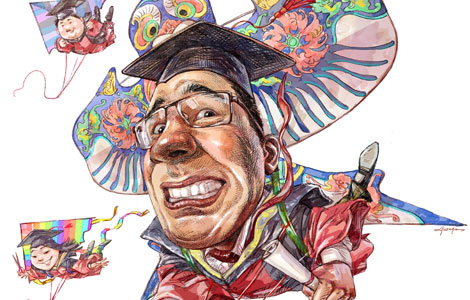A sculptor takes shape
Updated: 2013-11-03 08:15
By Chen Nan (China Daily)
|
|||||||||||
Wang Keping says he didn't aspire to become an acclaimed artist. He just wanted a tape player.
His initial motivation to sculpt came after his friend swapped an oil painting he'd created for a tape recorder from a foreign student in the 1970s.
"Western and Cantonese music was penetrating the mainland, and owning a tape recorder was a dream for young people," Wang recalls.
"I thought if I could create something like an oil painting, maybe I could get a tape recorder, too."
Wang still considers himself "an artist outside the art world".
Upon entering his solo exhibition at the Ullens Center for Contemporary Art in Beijing, the 64-year-old sculptor says: "I walked into the wrong room."
This is his first and largest exhibition of his work ever shown on the mainland since he moved to Paris in 1984.
The ongoing exhibition shows more than 50 sculptures he created over the past 35 years.
While Wang exploded in the newborn contemporary art scene in the late 1970s, he only participated in some small exhibitions. But he has been involved in the process from choosing works to curating this big event.
"I'm not an art school graduate. I believe my experience will encourage young, self-taught and glum artists," he says, laughing.
Wang influenced the early contemporary art scene as a founding member of the then avant-garde art group The Stars, co-established by giants like Huang Rui and Ma Desheng.
His iconic works Silence, Idol and Chain celebrate freedom and personal expression.

"We called it The Stars because we wanted to focus on each artist's variety and individuality," he says.
The group staged its first exhibition outside the National Art Museum of China in Beijing in 1979. It shocked society with its rebelliousness and originality.
UCCA director Philip Tinari says: "Every time I walked on the east side of the National Art Museum of China, I think of that exhibition September of 1979, which marked the beginning of China's contemporary art."
Wang was an actor and scriptwriter with a State-owned art troupe in Beijing until he started sculpting at age 30.
He studied painting with a friend but never cultivated a knack for it.
One day, he picked up a piece of wood on his way home and whittled it. He became obsessed.
"I felt proud and excited when I transformed a plain piece of wood into the shape I wanted," he says. "Surprisingly, my artist friends praised those works."
Wang often waits for years to let a tree grow into its distinct shape before sculpting it. His years of working with the medium have taught him how wood splinters. He believes his works are compromises between his aesthetic vision and the wood's inherent form.
"I feel like I'm conversing with each chunk," he explains.
"It gives me ideas. Trees are like humans. They have flesh and bone, tender parts, hard parts, solid parts, frail parts. You can't go against nature. You must follow it."
He moved to France to learn about great sculptors like Rodin, Maillol and Brancusi and compare his works with theirs.
"I learned my pieces are different from theirs," Wang says. "I didn't create with Chinese elements or according to Western trends."
His life in France is simple, he says.
Wang's studio is his garden.
"I am still rebellious and oppose the contemporary art scene's trends," he says. "I made personal artworks in the beginning. I'm glad I'm still doing it."
chennan@chinadaily.com.cn

(China Daily 11/03/2013 page15)
Today's Top News
Chinese Premier Li seeks point of balance
Reform roadmap before key meeting
Intel leaks proved justified: Snowden
Cooperation needed in terror fight
Beijing to further boost visa-free stay
Shenzhou X crew awarded for outstanding service
US to file murder complaint against LAX shooter
China's non-manufacturing PMI rises in October
Hot Topics
Lunar probe , China growth forecasts, Emission rules get tougher, China seen through 'colored lens', International board,
Editor's Picks

|

|

|

|

|

|





